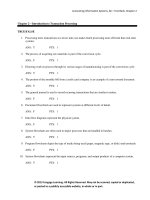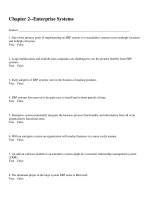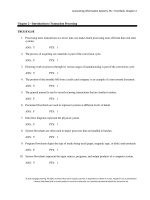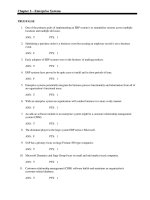Accounting information systems ch15
Bạn đang xem bản rút gọn của tài liệu. Xem và tải ngay bản đầy đủ của tài liệu tại đây (5.61 MB, 48 trang )
Integrated
Production
Processes
(IPP)
1
Learning Objectives
•
•
•
•
•
Appreciate the forces that exist in the
contemporary production environment
and the trends that have emerged
Understand role of enterprise systems in
the integration of the total manufacturing
environment
Understand the key inputs, outputs, data
processes and terminology included in
modern integrated production processes
Understand relationship between IPP and
other key business process within a
manufacturing organization, including
HRM, Purchasing, OE/S, and inventory
management
Understand the role of inventory
management systems and their
relationship to IPP.
IPP
IPP Process is a Spoke on AIS
Wheel
•
•
In this chapter, we give an
overview of one business
process, the integrated
production process (IPP).
We break down the basic
steps in the IPP, highlighting
the importance of:
– enterprise systems
– automation
– and integration between IPP
and the OE/S, purchasing,
HRM, and inventory
management processes for
success in today’s complex,
global manufacturing
environment.
3
Global Manufacturing
Environment
• Manufacturing is highly sought after by
developing nations
– Increases wealth and wages of population
• Global increases in manufacturing
forces domestic companies to become
more efficient
• Productivity increases in the U.S. is a
bright spot
4
Manufacturing Pressures
• Drivers of complexity reported by
Deloitte Touche Tohamatsu
– Pressure to reduce costs
– Pursuit of new markets
– Quickening pace of product innovation
5
Pressure to Reduce Costs
• Large retailers are exerting downward
pressure on prices
• Competition outside the U.S. adds downward
price pressure
• Moving aspects of the value chain to lowercost countries is often the option taken to
reduce costs
• Companies move everything from design to
raw materials supply overseas
6
Pursuit of New Markets
• China is a popular new market because
of its population and favorable business
climate
• Expanding into new markets is a
significant driver of complexity
• Large markets allow manufacturers to
recover product development costs
7
Quickening Pace of Product
Innovation
• Innovative new products are demanded
in the market and drive revenue growth
• Customization of products is required
by global markets
• Getting innovative products quickly to
market maximizes revenues
8
Successful Companies
• Deloitte & Touche report describes the
characteristics of successful companies:
– Improved internal business process
– Better use of technology
– Better general capabilities in critical areas
•
•
•
•
Collaboration
Flexibility
Visibility
Technology
9
Trends in Manufacturing
•
•
•
•
Product innovation
Production process innovation
Supply chain management
Management accounting systems
10
Product Innovation
• Enterprise systems facilitate the integration of
product design, manufacturing and marketing
• Innovation in value chain, from product
design through purchases and servicing
product
• Collaboration between design and
manufacturing for defect-free products
• Product lifecycle management (PLM)
software organizes data by product
11
Production Process Innovation
• Managing throughput time
– Throughput time is the actual time it takes to
complete a product from authorization to produce
to the finished product
– Decreases in throughput time tend to decrease
work in process and finished goods inventories
– Decreases in inventories means lower costs
– Throughput time has been decreased by switching
from “push” to “pull” manufacturing
12
Managing Throughput
Times
•
Push Manufacturing
– Sales forecast drives
production plan
– Goods produced in large
batches and inventoried
– Jobs wait between machines
– Similar machines organized
into departments
– Worker operates single
machine
•
Pull Manufacturing
– Demand (sales orders) pull
goods into production
– Production runs are short
– Continuous flow from one
operation to the next
– Machines organized into small
production lines called
production cells
– Workers are “cross-trained” on
multiple machines
– Reduced WIP and finished
goods inventories
– Reduced floor space from
better plant layout
13
Supply Chain Management
• The combination of processes and procedures used
to ensure the delivery of goods and services to
customers at the lowest cost while providing the
highest value to customers
• Manufacturer must forecast demand, determine lead
times, monitor inventory levels for numerous raw
materials, and plan for the manufacture of finished
goods
• Time and resources necessary to manufacture key
subassemblies, separately manufactured
components used in the final product, must be
considered
– These subassemblies may be manufactured in the same
plant as the final product, or they may be manufactured in a
separate plant across the globe
14
Supply Chain Management
• E-Business is increasingly important
• Internet technologies are being linked to
organizations’ ERP and supply chain
management software to provide
portals to external organizations for safe
and secure access of critical business
information
15
Supply Chain Management
• Supply chain management software provides for available to promise
and capable to promise planning.
• Available to promise planning is accumulation of the data on current
inventories, sales commitments, and planned production to determine
whether the production of finished goods will be sufficient to commit to
additional sales orders.
– Addresses the planned production capacity that can be used to fulfill
additional customer orders
• Capable to promise planning is the accumulation of the data on
current inventories, sales commitments, planned production and excess
production capacity, or other planned production capacity that could be
quickly converted to production of the desired finished goods necessary
to fulfill a sales order request.
– Addresses the capacity to divert production capacity from other production
facilities that have not been previously planned for use on producing the
product needed for an incoming customer order
16
Management Accounting
Systems Trends
• Enterprise software captures data and
makes it available across the value
chain
– Improved systems allow for many more
levels of analysis
– The emphasis in accounting is moving
toward analysis and away from transaction
processing and recording
17
18
Integrated Production Process
19
20
The objectives of CAD/CAE are to:
•
•
•
•
Improve design productivity
Reduce design lead time
Enhance design quality
Facilitate access to and storage of product
designs
• Make the design of multiple products more
efficient by eliminating redundant design effort
• Execute design changes almost immediately
through the use of electronic messaging to
notify the shop floor
21
CAD/CAE results in several data stores of
information that are used later in the IPP
• Bill of materials: Listing of all the subassemblies, parts, and raw materials
that go into a parent assembly showing the quantity of each required to
make an assembly
• Parts master—The parts master or raw material (RM) inventory master lists
the detailed specifications for each raw materials item
• Routing master—The routing master specifies the operations necessary to
complete a subassembly or finished good and the sequence of these
operations
– Includes the machining tolerances; the tools, jigs, and fixtures required; and the
time allowance for each operation
– Computer-aided process planning (CAPP): An automated decision support
system that generates manufacturing operations instructions and routings based
on information about machining requirements and machine capabilities
• Work center master—The work center master describes each work center
available for producing products, including information such as the machine
available at the station, its capacity, its maintenance needs, labor needs to
operate it, and so on.
– Workstation: Assigned location where worker performs his/her job
– Work center: Group of similar work stations
22
Generate Master Production Schedule
• The master production schedule (MPS) is a
statement of specific production goals developed
from forecasts of demand, actual sales orders, and/or
inventory information
– It describes the specific items to be manufactured, the
quantities to be produced, and the production timetable
• Depending on the company’s approach, the schedule
may be based on information about finished goods
inventory levels and reorder points, sales forecasts or
actual sales orders coupled with inventory levels
• Based on the master production schedule, more
detailed schedules for ordering raw materials and
scheduling work center operations are developed
23
Generate Master Production Schedule
•
The master production schedule is based on information
from three sources
1. The first is actual orders from customers
– Ideally, a manufacturer can cut throughput times to the point that
they can produce goods only as customer orders are received
2. Sophisticated demand forecasting models to estimate the
need for goods
– Use customer data in the enterprise system about past sales levels
and buying patterns to improve forecast accuracy
– Use information from the customer relationship management system
– Use data mining to identify patterns and relationships in the level of
demand
3. Finally, the inventory management system also provides
vital inputs to developing a better master production
schedule
24
Inventory Management
• Inventory Management System
– Provides data about levels of FG inventory on hand, and also gathers
data about goods scheduled to be produced.
– To develop better production schedules, the enterprise system tracks
inventory data over time including: lead times, optimal inventory levels,
frequency of stockouts, and expected quality levels all help develop
better production schedules.
• Global inventory management
– An inventory management approach where inventory needs and
inventory and production capabilities are matched across the entire
global enterprise
• Production, planning, and control is a process that manages
the orderly and timely movement of goods through the
production process. It includes:
– Planning material, people, and machine requirements; scheduling;
routing; and monitoring progress of goods through the factory
25









